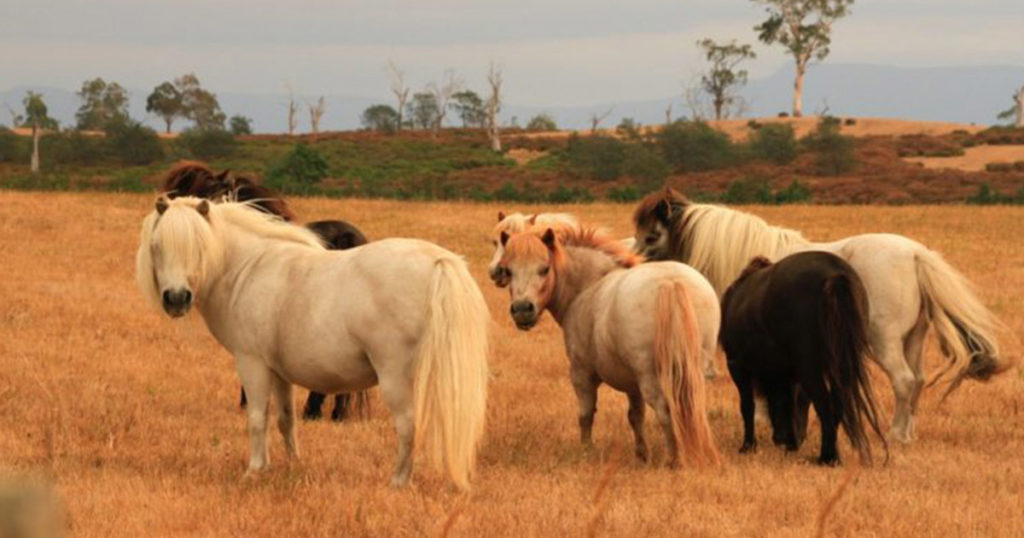Body weight, body condition and adiposity (levels of body fat) are factors which contribute to equine health in many different ways. Similar to the human population, the percentage of equines which are now overweight and/or obese continues to rise significantly. It is estimated in North America that more than 51% of horses and ponies are overweight or obese. Whilst many may view the well-rounded horse as ‘cute’, the health consequences of carrying excess body fat should not be ignored. In the first of this two part series we will explore what the overweight horse really is and the factors that contribute to this. Next month’s issue will address how to best prevent and manage overweight or obese equines holistically.
What defines overweight?
Recent research suggests that alarmingly many horse owners fail to recognise that their horse is significantly overweight or obese, believing that their horse is simply ‘big-boned’!
Body condition scoring is one of the most commonly and easily accessible methods used to determine a healthy weight or body composition for the adult horse. Depending on the model used, body condition scoring (BCS) can be rated from one to five (with one being very underweight and five being obese) or one to nine (with one being very underweight and nine being obese). Whilst both scoring systems are used interchangeably, in Australia it is more common to look at the former model. For the purpose of this article, we will refer to this model, aiming for a healthy BCS of three. For general health, respective scores of three (in the one to five model) and five (in the one to nine model) are a useful guide to aim for. Horses in high competition or heavy work will likely need to be slightly leaner than these scores, with the author believing that the scoring system of one to nine is more useful to assess such horses. Regardless, a horse which is kept at a leaner BCS for competition or work needs to have their feed intake sufficiently high enough to meet their energetic demands and remain in good health.
What does a healthy body condition score look like?
When aiming for a healthy BCS, fat deposition (or lack thereof) on several anatomical points of the horse are evaluated. Most commonly the neck, withers, loin, tail head, ribs and shoulder are assessed. For a horse with a BCS of three, the following should be aimed for:
Neck: The musculature of the neck should blend smoothly into the body, with no fat deposits or crests along the neck.
Withers: The withers should appear rounded over the spinous processes, without any fat deposition.
Loin: The back should be level, without either negative or positive crease lines (which are indicative of insufficient or excessive body condition respectively).
Tail Head: This will be dependant somewhat on the horse’s natural conformation, but generally speaking the fat above the tail should begin to feel slightly spongy. In a horse of lighter condition, the hook bones will be discernible, and in the overweight horse the fat around the tail head will feel soft.
Ribs: The ribs can be easily felt, but not visually distinguished. The overweight horse will have fat over the ribs, with increasing levels of fat making the ribs harder to feel.
Shoulder: The shoulder should blend smoothly into the body, without having fat depositions around it.
Health risks and problems associated with being overweight
In recent years, science has clearly demonstrated that adipose tissue (body fat) is more than merely a storage organ for fat (and therefore calories). It acts as an endocrine organ (meaning it produces and secretes hormones) and secretes inflammatory proteins that can greatly affect the horse’s health. Excess adipose tissue is a key component of a number of serious health problems, including insulin resistance, chronic inflammation and oxidative stress, arthritis, laminitis, decreased life span, infertility/subfertility, altered thyroid function, lipomas (fatty tumours which form in the mesentery of the intestines) and may cause colic, and poor heat tolerance.
Contributing factors to equine overweight/obesity
The factors which contribute to a horse being overweight or obese can be varied. In the most basic of cases, it can simply be that the horse has an intake of energy which is in excess of that expended (ie eating more than he/she is burning off through exercise and other basic metabolic activities). However, as in the case of humans, it is not always that simple!
Diet
Many dietary factors need to be considered and addressed when evaluating the contributors to equine obesity. Firstly, how much food is being fed? This is especially important in relation to concentrated feeds and rations. Many people feed their horses based on scoop sizes or even handfuls, which can vary dramatically between owners! The most accurate way to determine how much the horse is consuming is to measure the feed by weight.
An increased reliance upon highly processed, highly concentrated and often overly sweetened feeds also adds to an excessive energy intake. Even feeds which are touted as ‘low carbohydrate’, whilst potentially beneficial for some overweight horses, can actually be very high in energy. This is compounded by the fact that to meet vitamin and mineral guidelines advertised on the packaging, the suggested serving size of these feeds is often quite high, equating to a high energy intake. Additionally, many horses are now constantly grazing on improved, high-sugar pastures, contributing further to an excessive energy intake and lower fibre consumption. Insulin (which is the hormone primarily associated with controlling blood glucose levels) is also influenced by high energy and highly processed diets, leading to further difficulty in managing the obese horse.
On the flip side of excessive energy intake, a diet too low in energy can also contribute to obesity, likely through several mechanisms. A chronically low energy intake can cause the body’s metabolic rate to slow down, starve the body of essential nutrients needed for normal metabolic and hormonal health, interfere with thyroid function, and alter optimal gut microflora which is essential for energy production and metabolic health. This is further compounded by the diet which is low in roughage (hay and/or pasture).
Exercise
Many owners underestimate the amount of exercise their horse is undertaking. As for humans, for exercise to be effective both for fitness and weight management, it needs to be undertaken regularly, and gradually introduced. Most of us know of horses which are ridden infrequently (for example only on the weekends), then left in a small paddock for the rest of the week. Not only is this demanding on the horse’s body, but it also plays a role in contributing to low calorie burn and can contribute to aberrations in the stress hormone cortisol (see below).
Management
Keeping horses in stables, yards, small paddocks and isolation likely contributes to reduced energy expenditure through restriction on the amount of natural wandering and physical movement the horse undertakes daily. Left in their natural habitat, horses cover many kilometres daily, grazing and roaming- especially when in the company of other horses.
Medication
The increased use of and reliance upon conventional medications may contribute to the rise in obesity in horses. Medications which alter natural gastrointestinal tract microflora (such as antibiotics, NSAIDs- including bute, ulcer medications) and synthetic hormones used to regulate mare cycles- all have the ability to interfere with normal metabolic processes of the body. Fortunately, in most cases, optimal metabolic function can be re-instated with professional, natural, targeted treatment.
Stress
Stress can be a result of many factors: isolation; change in routine; alterations in feed; changes of paddock mates, etc, all of which can potentially contribute to a horse being overweight. Stress effects the production of the hormone cortisol, which in turn influences the hormone insulin: important for controlling blood glucose levels. Aberrations in cortisol levels through persistent stress is known to contribute to obesity.
Genetics
Similar to humans, another important factor influencing weight in horses is genetics. It is believed that some genetic populations are more prone to being overweight and suffering from metabolic conditions than others. This may be shadowed in the equine world: think of horse and pony breeds that are notoriously ‘easy keepers’ and gain weight very easily. Combine this with the fact that some of these breeds are known to have considerably lower metabolic rates, increasing their risk of obesity. In addition, it is believed that some breeds have less sensitivity to insulin, compounding the problem.

Camilla Whishaw is a highly regarded, experienced horsewoman and naturopath, helping to holistically treat and manage a broad range of equine health conditions and injuries, with a passion for mare and stallion fertility.
As a world-renowned practitioner, presenter, author, and consultant in the field of Equine Naturopathy, Camilla shares her knowledge through keynote presentations, interviews, lectures, panel sessions, and workshop training.





